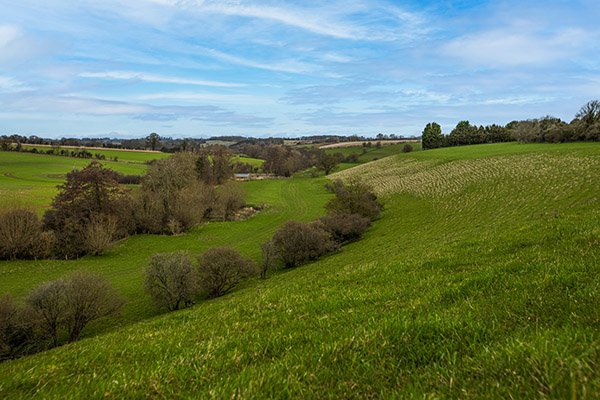The Group has signed an agreement with Blenheim Estate for the project to be delivered in conjunction with Grown In Britain, an independent not-for-profit that it helped set up in 2011, focusing on revitalising and investing in woodlands and certifying British wood products.
“This exciting project is about more than our quest to achieve net zero – though that remains our very valid goal,” said Chief Executive John Morgan. “This is about creating a legacy with an environmental net gain and the creation of substantial natural capital, across the board.

Arable farmland 2
“Our woodlands will provide measurable, demonstrable gains in terms of soil, air and water quality, not to mention the wellbeing benefits for all those who can come and enjoy the forest as it grows.”
Commenting on the new partnership, Blenheim Estates Director Roy Cox said: “One of our strategic aims in the next five years is to not only offset our own carbon to be net zero, but also to help others do the same.
“This partnership with Morgan Sindall is a first for us and is incredibly exciting in terms of both scale and what it will deliver in improving our estate, the environment and surrounding communities,’’ he added.
Long-term thinking
Though forests offer numerous benefits – including absorbing and storing carbon from the atmosphere, regulating temperature and cleaning the air, the UK is one of the least wooded areas of Europe, with less than 12% woodland cover compared to around 44% for Europe.
Morgan Sindall will help fund, design and create the woodlands, in collaboration with Cotswolds-based forestry company, Nicholsons.
The woods will incorporate 28 carefully selected varieties of trees – including Hornbeam, Lime, Sycamore, Wild Cherry, Oak, Norway Maple, Alder and Beech in the mixed woodlands with an understorey of woody shrub species including Hazel, Hawthorn, Viburnums, Euonymus and Dogwoods to create a diverse and self-sustaining eco-system. Experimental species will also be included to assess climate resilience and a small percentage of conifer planted to provide winter habitats for wildlife.
The project has been welcomed by Oxford University’s Professor of Biodiversity, Kathy Willis, Principal of St Edmund Hall.

Arable farmland
“This project demonstrates an understanding of the need for considered, long-term thinking around our woodlands and an appreciation of the crucial role they play in creating spaces that contribute to creating natural capital and enhancing human wellbeing,” she said.
A collaboration
This project, funded by Morgan Sindall, represents the first scheme planted under the Forest Canopy Foundation (FCF) – a not-for-profit collaboration of private sector forestry companies who have joined forces under the Foundation’s umbrella to demonstrate technical rigour and quality in woodland creation.
Partnering with Grown in Britain for independent auditing of both expert providers and woodland schemes, the collaboration measures all-natural capital assets – such as cleaner water and air and richer soil - seeking to share and deepen understanding of the worth of woodland creation.
Liz Nicholson, of the FCF, suggested that Morgan Sindall’s investment was pioneering and would blaze a trail for others to follow. The Foundation is working on valuing natural capital to enable companies to invest in environmental projects in a measurable way, developing mechanisms to report ESG investment at board level.
‘A different approach’
Far from a quick win, this will be a legacy project which - while it will have immediate impact in terms of biodiversity, soil erosion prevention and cleaner water - will sequester a total of 22,000 tonnes of carbon across a quarter of a century.
“This truly is a different approach,” said Dougal Driver of Grown In Britain. “While many choose to carbon offset by planting trees on the other side of the world, Morgan Sindall are taking a responsible approach – choosing sites in their own backyard, with a longer-term view and a commitment to support and nurture this forest for years to come.”
It is hoped the project, which will regenerate woodland in the Dorn and Glyme Valleys area of the Blenheim Estate will be the first of many for the Group.
Through the experience and knowledge gained, woodlands will also be integrated into many of its future designs for housing, development and urban regeneration projects.
‘Green Corridor’
The project will improve the biodiversity of the area significantly, improving the quality of soil, air, water and biodiversity.
“This will have a real and immediate impact on the Dorn Valley woodland at Blenheim, creating a ‘green corridor’ along the River Dorn which will prevent soil erosion into the world-famous Blenheim Great Lake,” said Roy Cox, Estates Director at Blenheim Estate.
“Crucially, it will also offer the opportunity for local people of all ages to get involved and improve the landscape we all share,” he added.
The project aims to set new standards for auditing and transparency, with changes to the air, water and soil monitored, and carbon levels tracked using state-of-the-art technology - including drones with Artificial Intelligence – to quantify environmental changes.
Morgan Sindall Woodlands map
Morgan Sindall and Blenheim Estate land to create new woodlands








